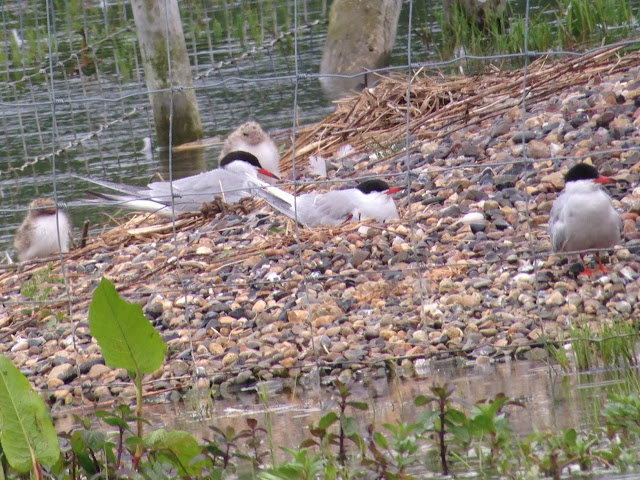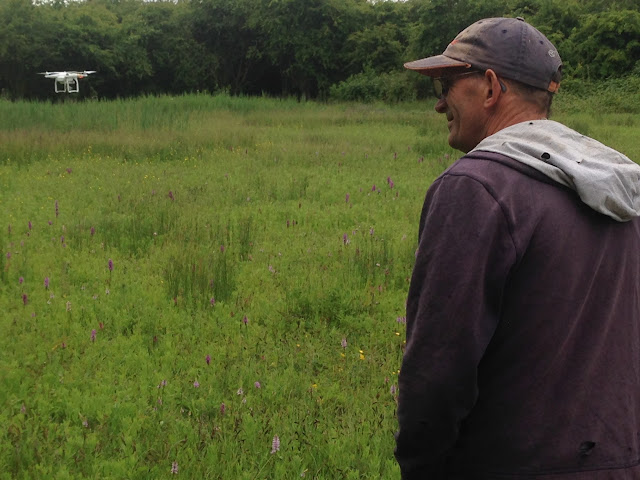We say 'hope' as the harmony seems to have disappeared. First casualty were the oystercatchers which failed after reaching nearly full term. We presume squabbles with black headed gulls put paid to that attempt - although they have subsequently been seen mating so we hope there'll be another attempt - Andy Marshall:
The main perpetrators as predicted however are the lesser black backed gulls. These menacing larger birds have already started on the neighbours - first to go was one of the tern nests that they had been sharing the island with. The debate was always out there as to whether choosing to nest here was a wise move on the terns part - and it now seems proven not. That said there have already been up to 11 tern chicks seen so hopefully a good proportion will escape.
Faring better at present seem to be the little ringed plovers - they successfully hatched all their eggs and last night at least all four chicks were readily visible in front of the hide on South Marsh East:
Couple of shelduck chicks still seem to be doing well:
So a great breeding season it would seem; A couple of Mediterranean gulls popped in on Sunday - Lukas Rowe:
But the year turns on - and now we're well into autumn migration. There's been a gradual ramp up in the numbers of waders visiting the southern marshes. Dunlin, wood, common and green sandpipers as singles all bode well, with 6 adult LRP's, and up to 78 lapwing in the last week:
Tweaking of levels will continue in coming days and weeks with the north lagoon to be drawn down for the first time in a decade to see what waders can be brought in here. Whilst prepping the dykes and ditches around site Roy Vincent uncovered this water shrew in the north lagoon outlet ditch and managed some rare pictures of this presumably common but elusive mammal:
Roy also snapped this more brazen mammal in D woods - stoat carting off tea.
Less welcome were reports of a mink at Watton railway crossing showing they are still very much in the wings. Otter has been seen repeatedly on North Marsh of late along with water voles. Grass snakes have moved into the new wildlife explorers built heap near east pond and over 6 were seen at Hempholme Meadow last week. That said hobby continues to eclipse all on north marsh - a cracking series of images from North Marsh by Roy Vincent:
Kingfisher still holding its own - Christine Watts:
But before we embrace the autumn passage an interesting aside has been the delayed flowering of orchids this season. Normally we say that the first week of June is the best for bee orchids but we seem a whole month late this year. Not as impressive a year for bee's however with only 6 logged this year compared to 199 last year - but they are notoriously erratic in their flowering;
Very impressive however have been the common spotted and marsh orchids with a spectacular purple carpet in south scrub:
An excellent spectacle and well worth capturing from above - we undertook some filming work with the team from the Yorkshire Wildlife Trusts Nature Tourism Team and photographer George Stoyle using a drone to capture some excellent vistas for a upcoming promotional film for East Yorkshire Nature Reserves:
Mike views his replacement;
It's been a good year generally for orchids and meadows we established a few years back seem to have finally come good as creeping thistle has disappeared - old wildlife centre:
And orchids move in:
More recently we've been undertaking thinning around some of the oaks in the woodland. This has given a bit of light to floor and produced a spectacular display:
A few other specialties like wood wasp by Andy Marshall:
And black tailed skimmer:Reserve walk coming up Saturday the 4th at 10am to see a selection of the above.































